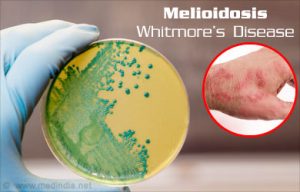US health officials are investigating the latest lethal case of a rare tropical sickness seen primarily in South Asia. According to the CDC, the unnamed victim, who died in Georgia last month, was the fourth instance of Melioidosis in the United States this year. A bacteria that dwell in soil and water is the primary cause of Melioidosis.
Experts are baffled as to why none of the Georgia, Kansas, Minnesota, or Texas made it to other countries. According to the Centers for Disease Control and Prevention, two people died due to the outbreak.
According to a federal health notice regarding the newest case, doctors should investigate Melioidosis if a bacterial illness does not respond to medications, even if the patient has not been outside of the nation.
The illness is curable, according to the CDC, if identified early and treated appropriately.
Despite the diseases being discovered in various locations at different times, the CDC claimed lab tests revealed the viruses were linked. Melioidosis is primarily a tropical illness that spreads by direct contact with a contaminated source. Melioidosis can affect healthy people, although it is more likely in persons with underlying medical problems. Diabetes, liver or renal illness, chronic lung disease, cancer, or any condition that impairs the immune system are important risk factors.
What is Melioidosis?

Melioidosis, commonly known as Whitmore’s sickness, is a contagious infection that can affect both humans and animals. Burkholderia pseudomallei is the bacteria that causes the illness. Melioidosis is caused by bacteria that may be found in polluted water and soil.
Humans and animals contract it through direct contact with a contaminated source. People can get Melioidosis by coming into close contact with polluted soil or water. Inhalation of contaminated dust or water droplets, ingestion of dirty water, ingestion of soil-infected food, or contact with contaminated soil, mainly through skin abrasions, are also the routes of infection for humans and animals.
It is highly unusual for someone to get the disease from someone else. While a few cases have been reported, the most common way humans become sick is through contaminated soil and surface water. Recent discoveries show tropical freshwater fish as a probable source of infection.
Melioidosis affects many animal species, including sheep, goats, swine, horses, cats, dogs, and cattle.
What are its symptoms?
Melioidosis comes in a variety of forms, each with its unique set of symptoms. However, it’s crucial to remember that Melioidosis includes a wide variety of signs and symptoms that might be confused for other illnesses like TB or more prevalent kinds of pneumonia.
The time after which the patient shows symptoms is not exact. It can range from one day to several years; symptoms usually show two to four weeks after exposure. Melioidosis can affect healthy persons. However, underlying medical problems might raise the chance of illness. The following are the primary risk factors:
- Diabetes
- Cancer or another immune-suppressing condition not related to HIV
- Hepatitis
- Renal disease
- Chronic Lung disease
- Thalassemia
Who are at risk of Melioidosis?
Melioidosis is an illness that is spread all over the world, but it is much more prevalent in northern Australia and Southeast Asia. However, the only sites in the US where this bacteria occurs naturally are Puerto Rico and the US Virgin Islands.
Each year, around a dozen instances are reported in the United States, with most cases occurring among visitors and immigrants from countries where the disease is common. In addition, melioidosis instances have been reported in the United States without a history of travel to places where the illness is common.
Furthermore, it has been discovered in personnel of various nationalities who have served in places where illness is prevalent.
Is Melioidosis treatable?
Doctors can treat this disease with the right medicine. The type of infection and the treatment regimen will influence the long-term prognosis. They provide intravenous antimicrobial medication usually for a minimum of 2 weeks (up to 8 weeks depending on the severity of the illness). The next step includes 3–6 months of oral antimicrobial therapy.
Prevention
You can contract Melioidosis by coming into touch with polluted soil or water in regions where the illness is prevalent. However, there are things that some groups of individuals may do to assist lower the risk of exposure in these areas:
- Melioidosis is more likely in those with open skin wounds, diabetes, or chronic renal illness. Therefore they should avoid contact with dirt and standing water.
- Those who work in agriculture should wear boots to protect their feet and lower legs from infection.
- When treating patients with Melioidosis, health care providers can take conventional measures to avoid infection.
Also, Read Five Most Common Phobia Around The World.









